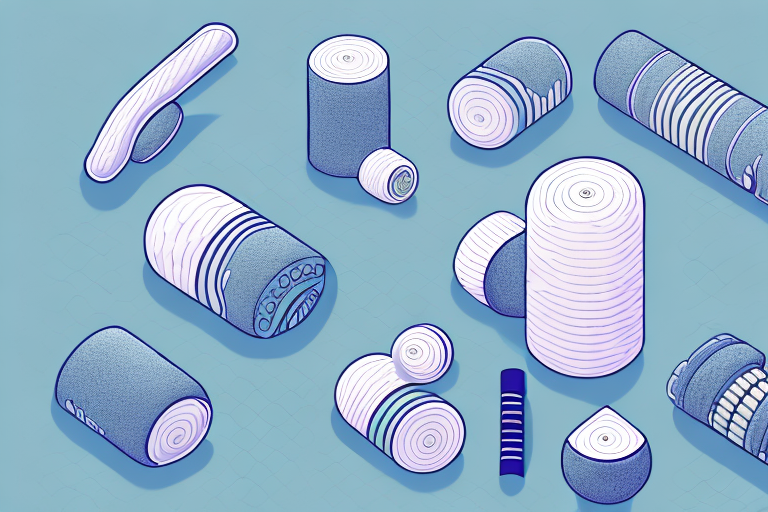If you’re an avid fitness enthusiast or just looking for ways to improve your mobility and flexibility, you may have heard of using foam rollers to relieve muscle tension and soreness. But have you heard of Vibrating Foam Rollers? They take standard foam rolling to the next level by adding powerful vibrations to enhance the massage-like therapy typically provided by foam rollers. In this article, we will explore how vibrating foam rollers work, the science behind the vibrations, the different types available, and their numerous benefits in pre- and post-workout recovery, injury prevention, and rehabilitation.
How Vibrating Foam Rollers Work to Relieve Muscle Tension and Soreness
When you work out, your muscles form lactic acid, which accumulates over time and can lead to muscle soreness, stiffness, and pain. A vibrating foam roller works by applying pressure to your muscles to release the accumulated lactic acid and other toxins from the muscle fibers. The vibration enhances the pressure, enabling you to apply more pressure to deeper layers of the muscle tissue, resulting in quicker and more effective relief of muscle tension and soreness.
In addition to releasing lactic acid and toxins, vibrating foam rollers also increase blood flow to the muscles. This increased blood flow helps to deliver oxygen and nutrients to the muscles, which can aid in the recovery process and reduce inflammation. Vibrating foam rollers can also be used for pre-workout warm-ups, as they can help to activate and loosen up muscles before exercise. Overall, incorporating a vibrating foam roller into your fitness routine can have numerous benefits for muscle health and recovery.
The Science Behind the Vibrations: Understanding the Mechanism of Action of Vibrating Foam Rollers
The vibrations in a vibrating foam roller work by stimulating your muscles’ natural reflexes, which help to relax the muscles and release tension. The vibration also activates proprioceptors in the skin, fascia, and muscles, which sense changes in muscle length and tension. As a result, your muscles become more receptive to the foam roller’s pressure, allowing them to relax and release tension, leading to reduced muscle soreness and stiffness.
In addition to reducing muscle soreness and stiffness, using a vibrating foam roller can also improve blood flow and circulation to the muscles. The increased blood flow helps to deliver more oxygen and nutrients to the muscles, which can aid in muscle recovery and growth. Furthermore, the vibrations can also help to break up adhesions and scar tissue in the muscles, which can improve flexibility and range of motion.
Different Types of Vibrating Foam Rollers: Which One is Right for You?
Vibrating foam rollers come in various types, including electric or battery-powered rollers, and hand-held or full-sized rollers. The choice of a roller will depend on your preference and your fitness goals. Hand-held rollers usually have one vibration level, while full-sized rollers typically have multiple vibration settings to enable you to adjust the massage to your comfort level.
Another factor to consider when choosing a vibrating foam roller is the texture of the roller’s surface. Some rollers have smooth surfaces, while others have ridges or bumps that can provide a deeper massage. Smooth rollers are ideal for beginners or those with sensitive muscles, while textured rollers are better suited for experienced users or those with tight muscles that require more intense pressure. It’s important to choose a roller with a texture that matches your needs and level of experience.
Benefits of Using a Vibrating Foam Roller for Pre-Workout Warmup and Post-Workout Recovery
Vibrating foam roller therapy can improve your flexibility and range of motion, which is essential for pre-workout warmups. Using the roller before a workout can help to increase blood flow and warm up the muscles, reducing the risk of injuries. On the other hand, using the foam roller post-workout can aid in recovery by reducing muscle soreness and speeding up the recovery process. Both pre-workout and post-workout are essential for optimizing your performance and avoiding injuries.
In addition to the benefits mentioned above, using a vibrating foam roller can also help to break up scar tissue and adhesions in the muscles. This can improve overall muscle function and reduce the risk of chronic pain and injury. Vibrating foam rollers are also portable and easy to use, making them a convenient tool for athletes and fitness enthusiasts to incorporate into their pre and post-workout routines.
Using a Vibrating Foam Roller for Injury Prevention and Rehabilitation: How It Can Help You Heal Faster
If you’re recovering from an injury, vibrating foam roller therapy can aid in the rehabilitation process. Foam rolling can help to break up scar tissue and increase blood flow, facilitating faster healing of the injured muscle. Furthermore, by improving your range of motion and flexibility, it can help to prevent future injuries by strengthening the muscles and increasing their resilience to injuries.
Additionally, using a vibrating foam roller can also help to reduce muscle soreness and stiffness. The vibrations from the foam roller can stimulate the nervous system, which can help to decrease pain signals and promote relaxation in the muscles. This can be especially beneficial after a strenuous workout or physical activity, as it can help to speed up the recovery process and reduce the risk of muscle fatigue.
How to Use a Vibrating Foam Roller Effectively: Tips and Techniques for Maximum Benefit
When using a vibrating foam roller, you want to ensure that you’re using it effectively to maximize the benefits. First, apply the roller to the affected muscle group and maintain pressure on the muscle for one to two minutes or until you feel the release in the muscle tension. Secondly, adjust the vibration intensity to find the right comfort level for your needs. Finally, remember to breathe deeply and slowly as you roll over the muscle to allow for better circulation and relaxation of the muscle fibers.
Comparing the Benefits of Using a Vibrating Foam Roller vs. Traditional Foam Rolling Techniques
While traditional foam rollers can be effective, vibrating foam rollers offer more benefits, including quicker and more effective relief of muscle tension and soreness, increased range of motion, facilitated injury prevention and rehabilitation, and better overall performance. Vibrating foam rollers also allow you to adjust the intensity, making it easier to target different areas of tightness in the muscles.
Overcoming Common Misconceptions About Using a Vibrating Foam Roller
One common misconception is that vibrating foam rollers are only suitable for advanced fitness enthusiasts. However, vibrations can help to enhance the massage therapy provided by foam rollers for individuals of all fitness levels. Another misconception is that the vibrations could be harmful to the muscles, but research suggests that there are no significant risks associated with using vibrating foam rollers.
The Future of Fitness Recovery: What Role Will Vibrating Foam Rollers Play?
The use of vibrating foam rollers in fitness recovery is on the rise and is poised to become more popular in the future. With additional medical research, there is potential for us to uncover additional benefits of vibrating foam rollers, including their impact on mental health and wellness.
In conclusion, vibrating foam rollers offer numerous benefits and are a natural and effective way to relieve muscle tension and soreness. Whether you’re looking to improve your pre- and post-workout recovery, prevent injuries, or rehabilitate an existing injury, vibrating foam rollers are an excellent addition to any fitness regimen. So why not give it a try and see for yourself the relief and improved mobility that vibrating foam rollers can provide?





